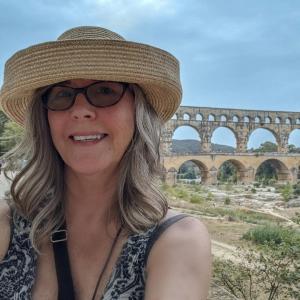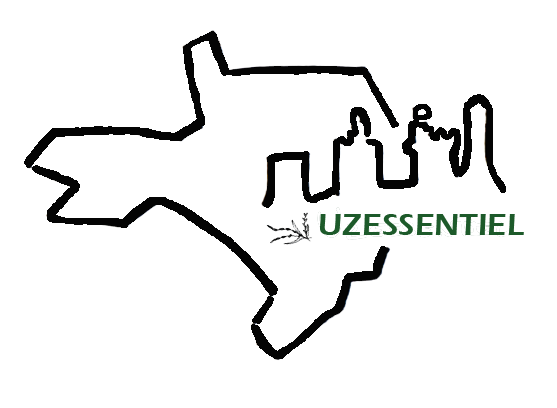Jules Larimore, author of The Cévenoles Sagas
- Par nbesse
- Le 02/01/2024
- Dans Interviews and portraits
FR - After Travels with a Donkey in the Cévennes (1879) of Scottish writer Robert Louis Stevenson, A book of the Cevennes published in the early twenties of Anglican priest, antiquarian and novelist Sabine Baring Gould, Notes from the Cévennes (2018) of British poet and novelist Adam Thorpe, comes the turn of Jules Larimore…
Want to know more about her and her love for writing? You are on the right page!
1st part of our paper dedicated to Californian writer Jules Larimore

LET’S CHAT
Hello Jules and welcome to the Interview section of UzEssentiel.com blog,
Can you present yourself to our readers?
Bonjour UzEssentiel readers! I am an author known by my nom de plume, Jules Larimore, and I am a descendant of several long lines of Cévenols going back from my eighth greatgrandfather, Jean Pierre Bondurant. He was a native of Génolhac who emigrated from France in 1697, during a resurgence in persecutions in the Cévennes, and eventually settled in the Virginia colony, becoming the progenitor of the Bondurant line in America.
His story inspired me to learn more about the Cévennes and to write about the Cévenols who lived during the tumultuous times of the Huguenot persecutions.
How did you come to your pen name Jules Larimore?
I had originally planned to use my own initials and surname, but I decided against it when I learned there was a popular science fiction writer in the 1940s-1970s using the same name and who was from the same hometown. I thought that would be very confusing, so instead, I decided to use another family name, Larimore. We believe it originates in France, but there is little to no information before colonial times. Using the name Larimore was also a dedication to my uncle, Jackson Larimore Snyder, who conducted much of our family genealogical research. For my prénom, I wanted a name that was French and gender-neutral, so I landed on Jules.
Since when are you dedicating yourself to writing, and more especially to writing about the Cévennes? Are you living there, full time?
I have been writing full-time since 2019 when health challenges forced me to quit working for a non-profit employer. Since then, I have been able to dedicate myself to my writing and work at a pace that allows time for the significant amount of research needed to write Historical Fiction. To date, all of my fiction writing is related to the Cévennes or Cévenols because of my endless fascination with the region. I suppose it is my ancestral connection to the land that draws me to the Cévennes and much of Occitanie, or the warm and welcoming nature of the people.
Although I would like to live full-time in southern France, I am currently only there a few weeks out of the year since I still have a full-time residence in Ojai, California. I will be in the Cévennes, Toulouse, and Carcassonne in September 2024 helping to lead a tour with local guide, Mariette Emilie, then I will stay in the area for some time after that. As I did this past year with the BritNimes group, I hope to arrange author talks with some of the bookshops in the area. I have been making plans to transition to living in Europe part of the year. While my choice of all the towns I have visited — during many trips, over many years — is Uzès, my partner is a surfer and he wants to be near the ocean, so perhaps it will be near Biarritz or Bayonne. We see that you are particularly fond of historical fiction…
I suppose that your medieval history, ancient Greek culture, anthropology, folklore studies are not “guiltless” about your passion? And that narrative composition and architectural design studies motivate you to start a career as a writer?
I have had a passion for history and discovering cultures of the past since I was quite young. I chose to take those courses at University so I could explore some of the various periods of history, and I found medieval European history to be my favorite. Architectural design studies gave me a good basis for settings, and a narrative composition course offered a foundation for fiction writing. But because of a debate with my instructor over the use of the “Oxford comma”, he dissuaded me from continuing to study writing. I finally picked up my studies in writing again several years ago, completing several Master Classes and workshops.
Did you have or still have a professional career apart from your writing?
My career path has been a crooked road that has finally led to writing full-time. In the past, I’ve worked in interior design, graphic design, and event planning for nonprofits. I also spent many years in marketing--which was an early outlet for creative writing--and writing freelance narrative non-fiction for print magazines and online publications in the responsible travel sector. Currently, my writing for magazines is focused on history.
You decided to apprehend history together with “an intimate relationship with the natural environment”… Why that, what was the penny drop of such interest in the relation human vs nature, a nowadays topical issue?
As a child, I spent summers at a family farm where the forests and streams were my playground and my friends were the wildlife and the fées. As I grew older, the forest became my spiritual sanctuary where I found a connection to the Divine that I could not find in a church or temple. That gave me a deep respect for nature and a passion for protecting our precious planet. I decided to impart that value of holding nature as sacred to the character of Jehan once I learned Jean Pierre Bondurant’s reasons for leaving the Cévennes.
Those reasons were not so straightforward and did not seem to be primarily for the sake of religion. It appears he also needed to avoid service in the Catholic militia, as was his duty as a noble, which would have caused him to fight against family and friends. By studying Jean Pierre’s recorded transactions in Virginia, it appears he preferred to have his own homestead in the wilderness, away from the Calvinist commune, than to be part of their church. Of course, someone like that would also take great joy in the wilderness of the Cévennes.

You describe your work as « books with a dose of magic, myth, and romance, distilled and blended with captivating settings, such as bucolic hamlets set in majestic mountains and dramatic river gorges, rolling plains, rustic inns, exquisitely crafted châteaux, mysterious carvings and symbology, ancient menhirs and dolmens”.
Can you explain your working method? Research, readings, meetings, interviews. I guess that you needed many guided visits of the Cévennes to really feel the atmosphere of the place?
I began research for The Muse of Freedom twenty-plus years ago shortly after I learned about my connection to Jean Pierre Bondurant. The first thing I did was to take a trip to Genolhac. It is important to me to embody the setting and culture first, to experience a place through its flora and fauna, geology and architecture, and to hear the voices of the people who lived during the era I am writing about, even before I do much other research. I have returned to the Cévennes a few times in recent years and had the opportunity to meet with the owner of the old Bondurant maison de ville in Genolhac, who shared a few secrets about the house and what transpired there. I was invited to visit, (even spending the night on my last visit), allowing me to experience the same sensations as my characters, to touch the same walls and windows, to walk across the same ancient stone floors, to look out onto the same garden. I have also spent much time in the Musée du Désert to learn about the tools, furnishings, clothing, weapons, and religious artifacts that were in use in the late 17th/ early 18th centuries. Fortunately, France does a wonderful job of digital archiving, so Departmental archives became a primary method for research.
One of my best sources has been Le lien des chercheurs Cévenols which just so happens to have been started by Jean-Francois Breton, the grandfather of the owner of the old Bondurant house. Msr. Breton’s co-editor was Jean Pellet who conducted significant research on the Bondurants and the house, and his work became the basis for Mary Bondurant Warren’s books on Jean Pierre Bondurant. A few of the other digital sources I use for primary records and scholarly papers are the departmental archives, Gallica, Gutenberg, Jstor, and various university and museum websites. Since the Cévennes National Park is an ecological preserve, I was able to find information on the flora and fauna of each particular setting location (with different microclimates) through their website and through those of naturalists who frequent the area. I also read a lot of books! Both nonfiction history and historical fiction that is set in the same eras and locales that I write about. I found historian Mary-Lucy Dumas' Genolhac sur la Regordane, tome 1 to be a wonderful source that encompassed so much of what I needed to represent life in 17th century Genolhac....
Good to know: The Muse of Freedom: first novel in the series from the Cévenoles Sagas, nº1 Amazon Bestseller in Renaissance Historical Fiction, Winner of New Voices Award by Writers & Publishers Network, Finalist in the Global Book Awards, Reader's Favorite Five Star Award, and Honorable Mention in the Historical Fiction Company’s Book of the Year Awards.
Many thanks to @juleslarimore, for her collaboration with this article and the visuals©juleslarimore. To learn more: Jules larimore.com.






